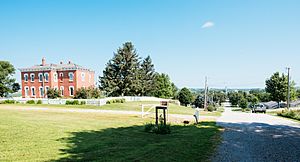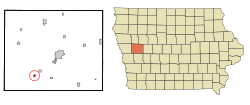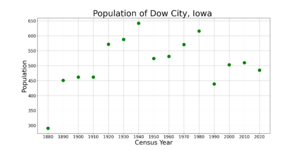Dow City, Iowa facts for kids
Quick facts for kids
Dow City, Iowa
|
|
|---|---|
 |
|

Location of Dow City, Iowa
|
|
| Country | |
| State | |
| County | Crawford |
| Area | |
| • Total | 0.33 sq mi (0.86 km2) |
| • Land | 0.33 sq mi (0.86 km2) |
| • Water | 0.00 sq mi (0.00 km2) |
| Elevation | 1,142 ft (348 m) |
| Population
(2020)
|
|
| • Total | 485 |
| • Density | 1,452.10/sq mi (561.14/km2) |
| Time zone | UTC-6 (Central (CST)) |
| • Summer (DST) | UTC-5 (CDT) |
| ZIP code |
51528
|
| Area code(s) | 712 |
| FIPS code | 19-22215 |
| GNIS feature ID | 2394557 |
Dow City is a small city located in Crawford County, Iowa, in the United States. It sits along the Boyer River. According to the 2020 census, about 485 people live there.
Contents
History of Dow City
Dow City was founded by Judge S. E. Dow. He settled in the area in 1855.
In 1869, Judge Dow planned out the town. He did this because he expected a railroad to be built through the area soon. The railroad station was finished in 1870.
The historic Dow House is located in Dow City. This important building was constructed in 1872.
Geography of Dow City
Dow City covers a total area of about 0.32 square miles (0.83 square kilometers). All of this area is land.
The city is situated on U.S. Route 30. It is also about thirty miles north of Interstate 80.
Population and People
| Historical populations | ||
|---|---|---|
| Year | Pop. | ±% |
| 1880 | 291 | — |
| 1890 | 451 | +55.0% |
| 1900 | 462 | +2.4% |
| 1910 | 462 | +0.0% |
| 1920 | 572 | +23.8% |
| 1930 | 588 | +2.8% |
| 1940 | 642 | +9.2% |
| 1950 | 524 | −18.4% |
| 1960 | 531 | +1.3% |
| 1970 | 571 | +7.5% |
| 1980 | 616 | +7.9% |
| 1990 | 439 | −28.7% |
| 2000 | 503 | +14.6% |
| 2010 | 510 | +1.4% |
| 2020 | 485 | −4.9% |
| Source: and Iowa Data Center Source: |
||
2020 Census Information
In 2020, there were 485 people living in Dow City. These people lived in 211 households. About 130 of these households were families.
Most residents, about 89%, identified as White. About 11.5% of the population identified as Hispanic or Latino.
The average age in Dow City was 41.1 years. About 27% of the residents were under 20 years old. Around 22% were 65 years or older.
2010 Census Information
In 2010, Dow City had a population of 510 people. There were 219 households in the city.
Most of the people, about 93%, were White. About 9% of the population identified as Hispanic or Latino.
The average age of residents was 42.4 years. About 24% of people were under 18 years old. Around 19% were 65 years or older.
Education in Dow City
Public schools in Dow City are part of the Boyer Valley Community School District. This district was formed in 1994. Before that, Dow City had its own school district called Dow City-Arion Community School District.
Notable Person
- Arthur Bowring was a rancher and a legislator. He was a notable person from Dow City.
See also
 In Spanish: Dow City (Iowa) para niños
In Spanish: Dow City (Iowa) para niños


